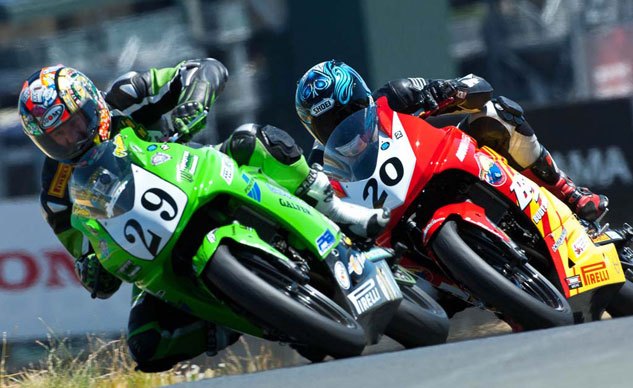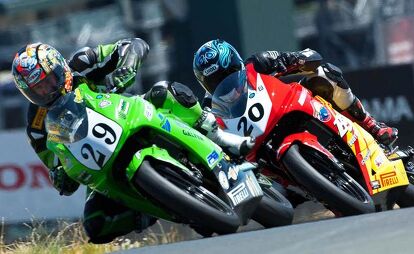Skidmarks - Slow Bikes Fast
Lead Photo: Brian Bartlow (29) and Kirk Korenko battling it out for first place, Sonoma Raceway 2011. Photo by Gary Rather.
I just had one of my best Thursdays ever. I was riding my favorite kind of sportbike – an itty-bitty one – on my favorite kind of racetrack – a tight and technical one. I was the second-fastest guy there. King of the world, Ma!
Because for me, the definition of awesome is a trackday where I have plenty of people to pass, but as of late, them peeps have been fewer and further between. Having a three-year-old son doesn’t help you go faster, nor do the effects of too many trips ’round the sun. Or of rarely having a motorcycle that makes much more than 70 horsepower.
Technology is the problem, or at least that’s what I like to think. Going fast is about comfort levels, and if you have enough electronic riding aids, you will feel comfortable at higher and higher speeds. A rider of my skill level has no business hitting 165 mph at the end of the straightaway at Palm Beach International Raceway, yet BMW‘s S1000RR let me do that without having an anxiety attack. I really shouldn’t be comfortable staying right behind an R1-mounted nine-time Isle of Man racer on a highly illegal Sunday morning jaunt up Highway 1, and yet, thanks to the unbelievably complex electronic systems on KTM‘s 1290 Superduke R, I was – 70 mph power wheelies and all.
Back when I was racing, the liter-class bikes were regarded by racers with a healthy dose of respect. There were no traction-control systems, no lean-angle-sensors, no ABS. The same went for the 750s, and the 600s, while fast, were slower and heavier than they are today. So when you’d do a trackday, if you were a reasonably competent rider on a lower-powered machine like a Suzuki SV650 or even a Kawasaki Ninja 250, you could mix it up comfortably with B- and even A-group riders, so long as the track was a technical one. That meant you didn’t see a lot of bikes bigger than 600cc at these events. When a literbike captain walked by in the pits, other riders would hush up respectfully – or snicker to each other out of earshot if they’d passed the guy in the last session.
Things have done a full 180. The last time I was at an open-to-the-public trackday, I may have been the only rider with less than 100 hp. The B-group was fine for me – I could still hold my own and didn’t have to worry about getting passed by those damned maniacs on 180-hp superbikes. Not only do new-bike buyers have access to World Superbike power, the technology that goes with them makes the power easy and safe to manage. How can that be a bad thing?
Well, it isn’t, really. Ride that rocket and you’re having fun on motorcycles. You are performing an exquisitely antisocial act, in this age of hypersafety and signing waivers to drive bumper cars. It’s thrilling to give a hard twist to a throttle coming off an 80-mph turn and feeling the front end get light while the rear end slides and grips, slides and grips. And when you can rip down a front straight, passing motorcycles like they’re traffic cones and near your rev limiter in 6th gear with confidence that your race-spec, ABS-equipped Brembos will haul you down to a safe entry speed for Turn 1, it’s a Godlike feeling that keeps you tingling for weeks. All that for $15,000? Cheap at twice the price.
That sounds pretty good, but if I had $15,000 I may just spend it on a weekend of vaguely legal vice in Las Vegas, which has just as much to do with what I think of as motorcycling. Tearing along at triple-digit speeds and then relying on electro-nannies to keep you from crashing in the corner is a terrific thrill, much like that place where you can rent machine guns off the Strip, or asking for the “extreme room” at the Mustang Ranch, but it’s not really what I had in mind my first season of roadracing.
Back then, it was me, a discounted set of leathers and a pre-scuffed 1988 Kawasaki EX250. My first seasons of racing were disappointing – I crashed a lot, finished near last place, blew up a motor or two, and didn’t have much technique or get much coaching. Traction control? ABS? You’re kidding, right? I was racing on Dunlop K591s, with a rear tire on the front wheel, as nobody made anything resembling a sport compound in the Ninja’s 16-inch front wheel size. We used to have ugly-bike competitions and regarded duct tape as a badge of honor – clean, shiny, undamaged bikes weren’t valued. “Hey, you haven’t crashed yet! Can I borrow your clutch lever?”
What we did value was riding ability. The winners were fearless in their corner speed, miserly with their brakes and smoother than Kim Kardashian’s frontal lobes. To roll off throttle a millisecond early meant losing – with more than 60 motorcycles gridded, one bad lap meant 20th place.
I spent a lot of money on the Ninjas I raced, but they taught me how to ride. It’s simple, really – ride a slow bike as fast as it will go, and then move up to the next-faster bike and repeat. Eventually, you’ll be on a literbike and nobody will be able to touch you. Unless they have the latest generation of electronics and a diminished self-preservation instinct, that is.
Of course, it’s always possible to not move up to the faster bikes. Observe the folks in the photos and tell me if you think they’d be having more fun or racing with any less passion if they had an extra 100 ponies, or if they’d get more out of their sport with the new R1. Racing is racing, and motorcycles are motorcycles, regardless of power output or engine configuration. Small bikes like Kawasaki’s Ninja 300, KTM‘s RC390 or the Yamaha YZF-R3 might be the last real sportbikes, with no need for traction control or quickshifters. They have more in common with classic racebikes like the Norton Manx or Ducati Diana than with the 600 and 1000cc spaceships they superficially resemble.
You ride them, not the other way around. You will learn to ride well or be passed. Entry level? More like rite of passage. Try one.
*I don’t know if the Mustang Ranch actually has an “extreme room,” and shame on you for Googling it.
Gabe Ets-Hokin was half of a famous lion-taming duo. After being injured in 2004 by a 7-year-old white tiger named Mantecore, he wrote the children’s classic book Bread and Jam for Frances. He lives in New York state with his wife and pet octopus, Neutron Bill.
About the photographer: Gary Rather has been shooting AFM races in Northern California for decades. Check out his portfolios to get a trackside view of the fastest club racing in the USA.
More by Gabe Ets-Hokin






































Comments
Join the conversation
I absolutely love this column, Gabe, you are spot on target, and remember the golden rule: It's always cooler to go fast on a slow bike than slow on a fast bike.
Help me please
http://www.gofundme.com/Dom...